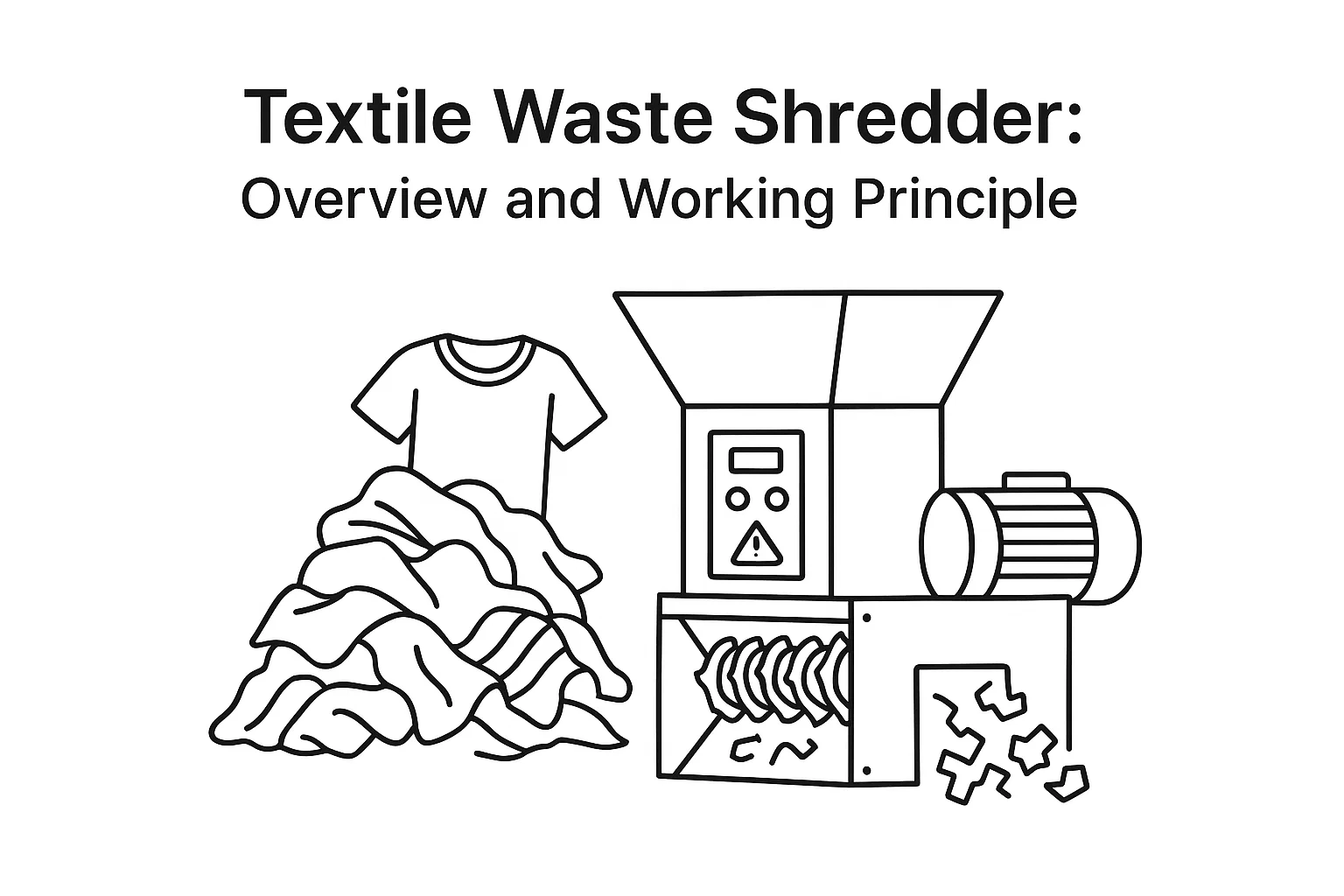مقدمة
Textile waste is a growing environmental and operational challenge for manufacturers, recyclers, and waste management companies. A textile waste shredder is a core piece of industrial equipment that reduces fabric waste into uniform pieces or fibers suitable for reuse, recycling, or energy recovery. This article explains the equipment overview, detailed working principle, typical applications, selection criteria, and practical tips for integrating shredders into a recycling workflow while highlighting how Rumtoo supports businesses in choosing and deploying the right solution.
What Is a Textile Waste Shredder
A textile waste shredder is an industrial machine designed specifically to break down fabrics, garments, carpets, and other textile materials into smaller, manageable pieces or loose fibers. Models vary by shaft configuration—single-shaft, dual-shaft, quad-shaft—and by intended output size, throughput, and material tolerance. Shredders handle both industrial textile offcuts and consumer-end textiles that may include zippers, buttons, and mixed-fiber blends.
Core Components of Textile Waste Shredders
- نظام التغذية: Controlled conveyors or hoppers that meter material into the cutting chamber to avoid clogging and ensure consistent throughput.
- Cutting Chamber and Rotors: Rotor assemblies fitted with specialized blades and counter knives tuned for fibrous, tough materials; rotor configuration influences shred size and throughput.
- نظام القيادة: Heavy-duty motors and gearboxes provide torque for processing dense or reinforced textiles; frequency inverters allow speed control for different fabrics.
- Screen and Sizing System: Perforated screens or secondary granulators achieve the desired particle or fiber size for downstream processing.
- Discharge and Separation: Conveyors, air separators, or magnetic systems remove non-textile impurities like metal fasteners and prepare material for further recycling steps.
Working Principle Step by Step
- Pre-sorting and Preparation
Textile streams are sorted by type, weight, and contamination level; large items or metal trims may be removed to protect equipment and improve efficiency. - Controlled Feeding
The feeding system meters material into the cutting chamber at a controlled rate, preventing overload and promoting uniform shredding. - Primary Shredding
Rotors and blades tear, shear, and cut fabrics into smaller pieces; blade geometry and rotor speed are optimized for different material toughness and blends. - Sizing and Secondary Reduction
Shredded pieces pass through screens or a secondary granulator to reach target particle size, producing flakes, strips, or loose fibers suitable for recycling lines. - Contaminant Removal and Quality Control
Downstream separation removes metals, elastics, and other impurities; quality checks ensure fiber length and cleanliness meet the requirements for reprocessing or product reuse.
Typical Applications and End Uses
- Fiber reclamation for regenerated yarn and nonwoven products.
- Insulation, padding, and stuffing materials for automotive and furniture industries.
- Secure destruction and volume reduction for defective or counterfeit garments.
- Fuel feedstock in waste-to-energy facilities when material quality is appropriate.
How Rumtoo Helps Buyers Select the Right Shredder
- Material Profiling: Rumtoo evaluates feed composition and contamination to recommend a correct shaft type and blade setup.
- Throughput Matching: We size machines to match production goals and downstream processes to avoid bottlenecks.
- Lifecycle Cost Analysis: Rumtoo presents trade-offs between capital cost, energy consumption, and maintenance to maximize ROI.
- Integration Support: Rumtoo assists with pre-sorting systems, magnetic separators, and conveyors to create a complete recycling line.
For detailed specifications and model options, see our recommended textile fibre shredder page: Textile fibre shredder
Choosing the Right Machine Criteria
- نوع المادة: Single-fiber streams demand finer shredding than mixed-consumer textiles.
- النتيجة المرجوة: Fine fiber reclaiming needs granulators and screening; coarse volume reduction can use dual-shaft models.
- Throughput Requirements: Match motor power and rotor configuration to expected daily tonnage.
- Contaminant Load: High impurity streams require robust feeding and separation systems to avoid downtime.
- Maintenance Accessibility: Choose designs with easy blade replacement and service access to reduce downtime.
أفضل الممارسات التشغيلية
- Implement pre-sorting to remove heavy contaminants before shredding.
- Use variable speed drives to tune rotor speed for different fabrics.
- Schedule regular blade inspections and replacements to maintain efficiency.
- Combine shredding with magnetic and air separation for higher recovered fiber purity.
التعليمات
What types of textile waste can a shredder process
Textile shredders process industrial offcuts, old clothing, carpets, nonwoven waste, and blended fibers; heavy contaminants like metal trims may require pre-removal.
How small can shredded textile particles be made
Particle size depends on screen and granulator configuration; outputs range from coarse strips to fine fibers suitable for regenerated yarn production.
What maintenance is required for a textile waste shredder
Routine blade inspection, rotor alignment checks, drive system lubrication, and separation system cleaning keep performance consistent and downtime low.
Are shredded textiles suitable for direct reuse in new textiles
Shredded fibers often require additional cleaning and blending processes before being spun into new yarns; suitability depends on fiber length and contamination level.
How does energy consumption vary between shredder types
الإعدادات المكونة من محور واحد ومحطم عادة ما تستخدم طاقة أقل لكل طن في الطحن الدقيق الخفيف؛ بينما تستخدم الآلات الثقيلة المكونة من محورين مزيداً من الزاوية ولكن تتميز في تقليل الكمية وتشغيل تدفقات المواد المختلطة.
دعوة إلى العمل
اتصل بـ Rumtoo اليوم للحصول على تقييم مخصص وعرض أسعار لاختيار أجهزة الطحن المثالية للنفايات النسيجية لتوافقها مع أهدافك الإنتاجية. اطلب عرض أسعار وبدأ في تحويل النفايات النسيجية إلى قيمة قابلة للقياس باستخدام حل إعادة التدوير الشامل والمدمج بشكل مهني.



